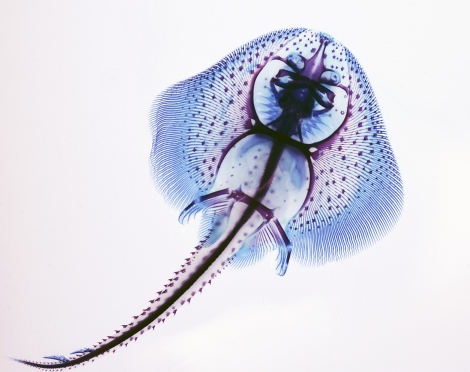Electric ‘Sixth Sense’ Evolved Differently in Sharks and Skates
Shark Sensory Neurons Appear Specialized for Hunting, While Skates Are Also Tuned for Communication

Sharks and ray-like skates have a sixth sense – they can detect the electrical fields produced by other living organisms, which can come in handy for homing in on prey obscured by the dark ocean or sandy seafloor. But while sharks and skates both use their electrical sense to hunt for hidden prey, skates also appear to communicate with one another by producing their own electrical fields.
Now researchers in the lab of David Julius, PhD, professor and chair of the UCSF Department of Physiology, have discovered that shark and skate electrosensory systems have distinct specializations that match how the animals use their electrical sense in the wild.
The Julius lab is well known for unraveling the mysteries of sensation – characterizing the receptor molecules responsible for heat of chili peppers, the pungency of wasabi, and the pain of snake venom, to name a few.
Recently, postdoctoral researchers Nicholas Bellono, PhD, and Duncan Leitch, PhD, have begun to unravel the long-standing mystery of how sharks and skates use their so-called electroreceptors to detect faint bioelectrical signatures in a crowded ocean. Last year, they revealed how the skate’s highly sensitive electrosensory organ works at a molecular level.
“It’s exciting to be able to bring new molecular tools to bear on understanding an exotic sensory modality that is used by many diverse animal groups, but which we have trouble relating to in a direct way as humans,” Leitch said.
The team’s latest findings, published online in Nature on May 30, 2018, showed how tiny molecular differences in the electrosensory neurons of the chain catshark (Scyliorhinus retifer) and the little skate (Leucoraja erinacea) lead to big differences in the animals’ sensory abilities.
Specifically, they found that catshark electrosensory cells appear to be wired for high sensitivity at the expense of subtlety: they respond strongly to any electrical signal that could indicate a nearby snack. In contrast, little skate electrosensory cells can tune their responses to subtle variations in electrical fields, perhaps to enable their communication with other skates, much like the human ear is attuned to the frequencies of human speech.
“We were interested in understanding the evolution of the electro-sensory system in these two different animals, and how they have adapted to accommodate their different lifestyles,” Bellono said. “To do that, we needed to investigate the specific molecular and biophysical properties in the sensory cells used for detecting electrical signals.”
The researchers showed that shark electrosensory cells use specific proteins that allow them to amplify faint electrical signals and respond quickly to repeated stimuli without losing sensitivity. The researchers also found that both shark and skate sensory cells have large, specialized ‘ribbon synapses’ that send a large and robust signal to the rest of the brain whenever they detect an electrical field.
In contrast to the strong all-or-none response of shark electrosensory cells, the researchers found that skate cells were more highly attuned to subtle variations in incoming signals and capable of passing on this information by adjusting the strength of the signal they send to the brain.
To test whether the differences they observed at the cellular and molecular level matched up with animals’ actual sensory abilities, the scientists measured how live sharks and skates responded, with changes in their ventilation rate (how rapidly the animals forced water through their gills, akin to human breathing), to a wide variety of electrical signals. In line with their molecular observations, they found that sharks responded with increased respiration to a wide range of electrical stimuli, while skates responded preferentially to low-frequency signals like those produced by the electric organs of other skates.
“This is not unlike the classic ‘cocktail party problem,’ that our ears and brain have to solve for sound,” said Julius, who holds the Morris Herzstein Chair in Molecular Biology and Medicine at UCSF, referring to the need to filter out distractions to communicate well with someone when there are several other loud conversations going on simultaneously in the same space. “There are lots of electrical signals in the ocean and these animals have to rapidly and accurately figure out which signals are relevant and how to respond.”
The findings help scientists understand the intricacies of underwater electrical communication and how different species evolve to specialize in their perceptions of the world. The electrosensory system of sharks and skates is also related to our own auditory systems, so new insights about electrosensation in fish could one day also help us better understand ourselves.